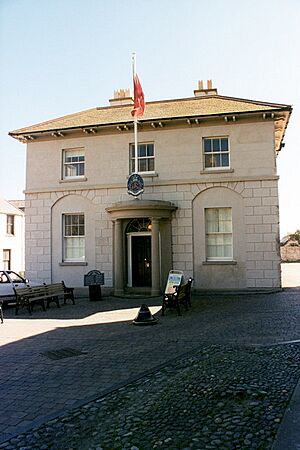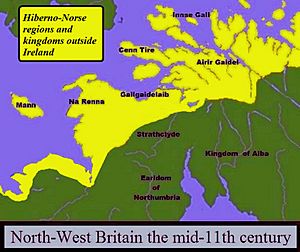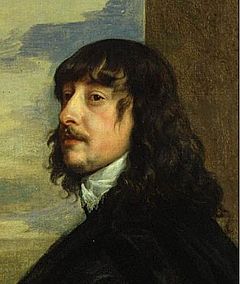History of the Isle of Man facts for kids
The Isle of Man became separate from Great Britain and Ireland around 6500 BC. People first settled on the island by sea during the Mesolithic era, which was about 8,500 years ago. Over time, different raiders and traders visited the island.
After people from Ireland settled there in the first century AD, the Isle of Man became Christian. Later, Vikings from Norway raided the island. The Isle of Man then became part of the Norwegian Kingdom of Mann and the Isles. After that, it was owned by the Scottish and then the English kings.
Since 1866, the Isle of Man has been a Crown Dependency. This means it is a territory that belongs to the British Crown but governs itself. It has democratic self-government, so its people can make their own laws.
Contents
Ancient History of the Isle of Man
Early Stone Age Settlers
The Isle of Man became an island about 8,500 years ago. This happened when melting glaciers caused sea levels to rise. Before this, there was a land bridge connecting the Isle of Man to Cumbria in Britain.
The first signs of people on the Isle of Man are from the Mesolithic Period (Middle Stone Age, 8000 BC - 4000 BC). These early people were hunter-gatherers. They lived in natural shelters and found their food by hunting, gathering plants, and fishing. They used small tools made from flint or bone. These tools have been found near the coast and are now kept at the Manx National Heritage museum.
From Farming to Bronze Age Monuments
The Neolithic Period brought big changes, like farming, better stone tools, and pottery. During this time, large stone structures called megalithic monuments were built around the island. You can see examples at Cashtal yn Ard near Maughold, King Orry's Grave in Laxey, Meayll Circle near Cregneash, and Ballaharra Stones in St John's. There was also a local group called the Ronaldsway culture, which lasted from the late Neolithic into the Bronze Age.
Iron Age and Celtic Influence
The Iron Age saw the start of Celtic culture on the island. People built large hill forts on top of hills and smaller forts along the coast. They also built big roundhouses with timber frames.
The first Celts on the island were likely Brythonic tribes from mainland Britain. We don't know much about the Isle of Man during the Brythonic period. It's not clear if the Romans ever landed on the island. However, a Roman amphora (a type of jar) was found at a settlement on South Barrule. This suggests there was some trade or contact with Roman Britain.
It is thought that Irish people came to the island around the 5th century AD. This led to the development of the modern Manx language. The island is named after Manannán, a Celtic sea god who, in myths, once ruled the island.
Middle Ages on the Isle of Man
Early Christian Times
Tradition says that St Maughold (Maccul), an Irish missionary, brought Christianity to the island. There are remains of about 200 tiny early chapels, called keeils, spread across the island. Evidence suggests many of these were built around AD 550–600.
The Brythonic culture of Manaw is mentioned in old British stories and later Welsh writings. The family of Gwriad ap Elidyr, a famous figure, is linked to a Manaw. A cross found in 1896, called Crux Guriat (Cross of Gwriad), supports this idea.
In 577–578, Báetán mac Cairill, a king from Ireland, led an expedition to Man and took control. After his death, Áedán mac Gabráin, another king, is said to have taken the island in 582.
Viking Age and Norse Kingdom

From about AD 800 to 815, the Vikings came to Mann mainly to raid and take treasure. From about 850 to 990, they settled down. During this time, the island was ruled by the Scandinavian Kings of Dublin. From 990 to 1079, it was controlled by the powerful Earls of Orkney.
Between 1025 and 1065, coins were made on Mann. These Manx coins were copied from Irish-Norse coins from Dublin. This shows that Mann might have been under Dublin's control then.
We don't know much about Godred Crovan, who conquered the island in 1079. He created the Kingdom of Mann and the Isles. This kingdom included the southwestern islands of Scotland until 1164. In 1154, the Diocese of Sodor and Man, a church area, was formed.
The islands under Godred's rule were called the Suðr-eyjar (South Isles). These included the Hebrides and other smaller western islands of Scotland, along with Mann. Later, his successors called themselves the Rex Manniae et Insularum (King of Mann and of the Isles). The capital of the kingdom was on St Patrick's Isle, where Peel Castle was built on an old Celtic monastery site.
Olaf, Godred's son, was a powerful ruler. He had strong alliances with the kings of Ireland and Scotland. Because of this, no one dared to bother the Isles during his time (1113–1152). In 1156, his son Godred (ruled 1153–1158) lost the smaller islands off Argyll. This happened after a fight with Somerled, the ruler of Argyll. This created a new independent kingdom between the two parts of Godred's kingdom.
In the 1130s, the Catholic Church sent a mission to set up the first bishopric on the Isle of Man. They appointed Wimund as the first bishop. However, Wimund soon became a leader of murder and looting throughout Scotland and the nearby islands.
Throughout the Scandinavian period, the Isles were officially under the Kings of Norway. But the Norwegian kings only sometimes showed strong control. The first king to really control the area was likely Magnus Barelegs around 1100. Another king, Haakon Haakonsson, didn't return to the Isles until his expedition in 1263.
End of Norse Rule
From the mid-1100s to 1217, Norway's control was weak because of civil wars. But after 1217, Norway became stronger. This led to conflicts with the growing power of the kingdom of Scotland.
In the early 1200s, Ragnald (ruled 1187–1229) showed loyalty to King John of England. This was the first time England got involved in Manx affairs. But Scotland would control the island before England took full control.
In 1261, Alexander III of Scotland tried to buy the islands from Norway, but it didn't work. So, he started a war. This war ended with the Battle of Largs in 1263, which was not a clear victory for either side. However, the Norwegian king Haakon Haakonsson died that winter. This allowed King Alexander to win the war. Magnus Olafsson, King of Mann and the Isles (ruled 1252–1265), who had fought for Norway, had to give up all the islands he ruled, except Mann. For Mann, he swore loyalty to Scotland. Two years later, Magnus died. In 1266, King Magnus VI of Norway gave the islands, including Mann, to Scotland in the Treaty of Perth. Scotland paid 4,000 marks and an annual payment of 100 marks. But Scotland's rule over Mann wasn't firm until 1275. That's when the Manx were defeated in the important Battle of Ronaldsway, near Castletown.
English Control Begins
In 1290, King Edward I of England took control of Mann. It stayed in English hands until 1313, when Robert Bruce captured it after a five-week siege of Castle Rushen. Around 1333, King Edward III of England gave Mann to William de Montacute. He owned it completely, without having to serve the king.
In 1346, the Battle of Neville's Cross decided the long fight between England and Scotland in England's favor. King David II of Scotland was captured and later ransomed. But when Scotland couldn't pay one of the ransom parts, David secretly agreed with King Edward III of England to cancel it. In return, he would transfer the Scottish kingdom to an English prince.
After this secret agreement, Mann was sometimes under English rule and sometimes Scottish. In 1388, the island was "ravaged" by Sir William Douglas of Nithsdale.
In 1392, William de Montacute's son sold the island to Sir William le Scrope. In 1399, Henry Bolinbroke had Le Scrope beheaded. Le Scrope had supported Richard II when Bolinbroke took the throne. The island then came under Henry's control. In 1405, Henry gave it to Sir John I Stanley of the Isle of Man for life. In 1406, this gift was extended to Sir John's heirs. They would rule the island under the English Crown. Their payment was to show loyalty and give two falcons to all future Kings of England at their coronations.
Early Modern Period
The Stanley Family Rules
When the Stanley family took control, Manx history became more stable. The new rulers rarely visited the island. Instead, they appointed governors who usually treated the people fairly. Three members of the Stanley family had the most impact: the second Sir John Stanley (1414–1432), James, the 7th Earl (1627–1651), and the 10th Earl of the same name (1702–1736). They limited the power of church leaders, introduced trial by jury, and ordered the laws to be written down. James, the 7th Earl, known as the Great Stanley, and his wife, Charlotte de la Tremoille, are very important figures in Manx history.
Wars and Changes (1642-1660)
Soon after the Wars of the Three Kingdoms began in 1643, James Stanley, 7th Earl of Derby, returned to Mann. The island was close to rebellion. People were unhappy about high payments to the Church of England. They also disliked Derby's attempts to change their land ownership system. He managed to calm things down but made few changes.
After King Charles I of England was executed in 1649, Derby was asked to give up the island, but he refused. In 1651, he and 300 Manxmen went to England to fight in the Third English Civil War. They were defeated, and Derby was captured and executed in October 1651.
After Stanley's death, the Manx Militia, led by William Christian (known as Illiam Dhone), rebelled against the Countess. They captured all the island's forts except Rushen and Peel. Then, a Parliamentarian force from England joined them. The Countess surrendered after a short fight.
Oliver Cromwell appointed Thomas Fairfax as "Lord of Mann and the Isles" in 1651. So, Mann continued to have a ruler and kept its relationship with England.
Return of the Stanley Family (1660)
When the Stanley family returned to power in 1660, there were few problems. One of the first things the new Lord, Charles Stanley, 8th Earl of Derby, did was to have William Christian tried. Christian was found guilty and executed. Only three other people involved in the rebellion were not pardoned. However, King Charles II later pardoned them, and the judges who sentenced Christian were punished.
Charles Stanley then tried to change the tenants' land rights. This almost caused another rebellion and led people to focus on fishing and illegal trade instead of farming.
Charles Stanley died in 1672. His son, William Richard George Stanley, 9th Earl of Derby, ruled until his death in 1702.
The land issue was finally settled in 1704. James Stanley, 10th Earl of Derby, William's brother, made an agreement with his tenants. This agreement became a law called the Act of Settlement. It gave tenants permanent ownership of their land for a fixed rent and a small fee when the land changed hands. This act was so important to the Manx people that it was called their Magna Carta. Over time, the rent paid to the Lord became very small. It was finally bought out in 1916.
The Revestment (1765)
James died in 1736. The island's ownership passed to James Murray, 2nd Duke of Atholl. In 1764, his daughter Charlotte and her husband, John Murray, became the Lord and Lady of Mann. Around 1720, illegal trade, or smuggling, grew a lot. In 1726, Parliament tried to stop it, but it became a huge problem between 1756 and 1765. To stop this, Parliament passed the Isle of Man Purchase Act 1765 (called the Revestment Act by the Manx). Under this act, Parliament bought the Atholls' rights as Lords of Mann, including the island's customs money, for £70,000. They also gave the Duke and Duchess a yearly payment.

The Atholls still kept their land rights and other benefits until they sold them for £417,144 in 1828.
Before the revestment, Tynwald (the Manx parliament) made laws for the island and controlled its money. After the revestment, the British Parliament in Westminster started making laws about customs, harbors, and shipping. It also took control of the island's customs duties. These changes, rather than the transfer of full ownership to the King of Great Britain, changed the Isle of Man's government. Its old laws and land ownership stayed the same. However, the revestment had some negative effects. The old Lords of Mann had often cared about the islanders. But now, officials from England ran things. They saw the island as a place full of smugglers and tried to get as much money as possible from it.
Things got a bit better between 1793 and 1826 when John Murray, 4th Duke of Atholl, was governor. Even though he argued with the House of Keys and cared too much about his own money, he sometimes worked to help the island. After he left, English officials took over again, but they were more understanding. Also, smuggling had almost disappeared, and the island's income was growing. Because of this, and because the Manx people spoke to British ministers, the island got better customs rules and some money for public works.
Modern Isle of Man
Progress and Autonomy
Since 1866, when the Isle of Man gained some self-government, the Manx people have made great progress. Today, it is a successful community with a strong offshore financial centre, a tourism industry (though smaller than before), and other businesses.
The Isle of Man was used for civilian internment camps during both the First World War (1914–18) and the Second World War (1939–45). In the First World War, there were two camps: one in Douglas and a purpose-built camp near Peel. In the Second World War, there were smaller camps in Douglas, Peel, Port Erin, and Ramsey. The Manx Regiment was formed in 1938 and fought in the Second World War.
On August 2, 1973, a fire at the Summerland amusement center in Douglas tragically killed between 50 and 53 people.
The early 1900s saw a return of Manx music and dance. The Manx language also saw a small revival, even though the last native speaker died in the 1970s. In 1947, the Irish leader, Éamon de Valera, visited. He was unhappy with the lack of support for Manx, so he sent recording vans to help preserve the language.
During the 20th century, the Manx tourist economy declined. This happened as English and Irish people started flying to Spain for package holidays. The Manx Government responded by promoting the island as an offshore financial center, thanks to its low tax rates. While some worry about money laundering, the island has avoided being blacklisted as a tax haven.
In 1949, an Executive Council was created. It was led by the Lieutenant-Governor and included members of Tynwald. This was the start of power moving from the unelected Lieutenant-Governor to elected Manx politicians. Control over finance and the police moved to Manx control between 1958 and 1976. In 1980, a chairman elected by Tynwald replaced the Lieutenant-Governor as head of the Executive Council. In 1985, the Executive Council was changed to include chairmen of the main government departments. In 1986, these chairmen were called "Ministers," and the chairman was called "Chief Minister." Sir Miles Walker CBE became the first Chief Minister of the Isle of Man in 1986. In 1990, the Executive Council was renamed the "Council of Ministers."
The 1960s also saw a rise in Manx nationalism. This led to the creation of parties like Mec Vannin and the Manx National Party.
On July 5, 1973, control of the postal service moved from the UK to the new Isle of Man Post. The island then started issuing its own postage stamps.
The 1990s and early 2000s have seen more recognition of local Manx culture. This includes the opening of the first primary school that teaches in the Manx language.
Since 1983, the Isle of Man government has named over 250 historic buildings as Registered Buildings of the Isle of Man.
See also
 In Spanish: Historia de la Isla de Man para niños
In Spanish: Historia de la Isla de Man para niños
- King of Mann (1164–1504)
- Internment camps in the Isle of Man
- Extinct animals from the Isle of Man
- Registered Buildings of the Isle of Man





